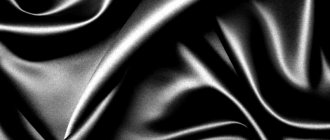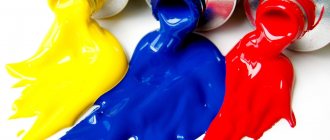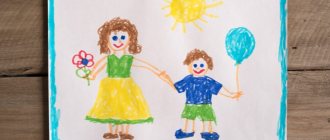Surely you have noticed that if a child likes a certain color, he chooses it in everything. Clothes, toys, accessories, and even balloons or ice cream should be your favorite color. And nothing can be done - this is the period.
In fact, children are instinctively drawn to those colors that are most pleasant and useful to them at a given stage of development. Scientists have proven that colors have the ability to have a powerful effect on the psyche. This is especially true for children, because a child’s visual perception helps him understand the world. Color can bypass the “obstacle” of our consciousness and act on an unconscious level. This property is used in alternative medicine - color therapy.
HOW TO APPLY KNOWLEDGE ABOUT FLOWERS
As you can see, by studying the psychology of color, you can carefully influence the child’s psyche and mood. Some shades calm and relax, others invigorate and give strength. When choosing a color, be guided by the temperament and character of the children, and also take into account their biorhythms and condition at a particular moment in time.
For example, in the morning we all lack energy. Serving your baby breakfast on an orange plate will give him energy for the day ahead. But in the evening it is better to listen to fairy tales, wrapped in a soft green blanket.
For walks on a gloomy autumn day, wear boots and a raincoat in rich colors. These clothes will lift your spirits. And when choosing pajamas, give preference to calm tones.
It is better to decorate the room of energetic fidgets in neutral colors. Bright accents in the interior will help those who are shy and less active to relax.
Now you are armed with knowledge, but do not forget to rely not only on theory, but also on the baby’s preferences. After all, the main thing is that you like the color and please the eye.
Your child’s favorite color and character (over three years old)
For a very long time, scientists of various sciences, psychologists, teachers, physicists, psychiatrists have proven the influence of color on our character and style of behavior. A favorite color can tell a lot, especially if the color is most often used in the process of visual activity.
What does your favorite color say?
Who prefers red , representing activity and energy, strength and courage. Young and adult lovers of red are usually fighters by nature and leaders in their environment. They have high performance and low fatigue.
The main qualities of a child who prefers the color red: willpower, eccentricity, outward focus, aggression, increased activity, excitability, determination, and temper.
The color of blood, health, life, energy, strength, power. These children are open and active. It is very difficult for parents with “red” children: lively, disobedient, excitable, restless, breaking toys. When they grow up, their high performance will be determined by the desire to achieve success, get results, and earn praise. Hence the assertiveness and selfishness. The interests of today are above all for them. If there is no red in your child's drawing, he is most likely irritated by the color. In this case, the child has an inferiority complex and strives for solitude. According to psychologists, most often children who “avoid” the color red are raised in families where quarrels often arise between parents, and the family environment in the house is turbulent.
Lilac , along with pink and purple, is one of the favorite colors of little girls. This color symbolizes children's impressionability and suggestibility, the need for support, support, tenderness, and defenselessness. A “lilac” child often invents his own world, as a rule, is endowed with a rich imagination and is very artistic.
Pink is the color of optimism, carelessness and coquetry. Pink is the favorite color of little girls. The creators of Barbie dolls take advantage of this, and for many years now they have been selling them in bright pink boxes, accompanied by furniture, clothes and accessories in the same pink tones. People with a sweet tooth also love pink, and confectioners know this. Try to imagine cream, marshmallows, marshmallows, lollipops, ice cream - what color do you associate them with? Pink color relaxes like no other. It represents affection, love, tenderness, romance, sentimentality, irresponsibility, immaturity, childishness and a bit of extravagance. Pink is a “soft” color - red mixed with white. Its psychological strength is weaker than that of red, which represents activity and energy, strength and courage. The main qualities of a child who prefers the color pink: sophistication, compassion, tenderness, weakness, timidity, sentimentality, optimism. Girls usually prefer pink. The “pink child” is usually gentle, weak, and timid. Such a child is very dependent on others and needs constant support. When a boy prefers pink, he shows up stronger as a person. If your child chooses pink, it means he needs more frequent expressions of love from you. These children need constant tactile contact. They need a kiss before bed no less than air.
The main qualities of a child who prefers lilac : weakness, tenderness, loneliness, defenselessness, self-containment, musicality, honesty. This color is usually preferred by girls. He talks about such character traits as weakness, tenderness, feelings of loneliness, and defenselessness. The “lilac” child is often immersed in his own world and, as a rule, is very artistic.
The main qualities of a child who prefers purple : fantasy, intuition, sensitivity, vulnerability, rich inner world, emotional and intellectual immaturity (children often prefer this color). In the language of color, purple means night, mystery, mysticism, contemplation, suggestibility. These children live a rich inner world and are distinguished by artistry and are very sensitive. They are easy to hypnotize and are excitable. They strive to impress, but at the same time they are able to look at themselves from the outside. They are very vulnerable and need support and encouragement more than others.
Blue color is popular with children who love freedom, independence, change of scenery, traveling to new places, playing outdoors and splashing in the water. A child who prefers the color blue is friendly, benevolent, easily makes new acquaintances, but at the same time he is quite serious compared to other children, prone to thoughtfulness and attentive to such details and nuances of ongoing events that other people do not notice. Just like pink, blue represents carelessness and carelessness, but that's where their similarities end. The main qualities of a child who prefers the color blue: carelessness, carelessness, optionality and a tendency to frequently change lifestyle. Unlike pink, it is not “assigned” to people of the same gender and a certain age. Boys usually prefer blue. Often such boys grow up to be sailors or pilots.
Constant attachment to blue means that the child craves peace. He often needs to rest, he gets tired quickly. An avid lover of the color blue is a quiet, affectionate, sensitive and slightly fearful child. By temperament, most likely - melancholic, possibly phlegmatic. Such children usually love quiet games, books and the computer. They are often called "nerds". The main qualities of a child who prefers the color blue: concentration, focus on internal problems, the need for peace and satisfaction, introspection, calmness, fidelity. "Blue" children are the complete opposite of "red" ones. It’s not for nothing that “red” children can be calmed down with blue, and “blue” children with red. A “blue” child is calm, balanced, and likes to do everything slowly and thoroughly. He enjoys lying on the sofa with a book, thinking, discussing everything in detail. He prefers intimate friendship with dedication and self-sacrifice, because, in contrast to the “red” children, he enjoys giving rather than receiving. “Blue” children are devoid of selfishness and are prone to self-sacrifice. From this type of people philosophers grow. Often children choose blue not because they are calm, but because they really need peace at the moment.
Green often becomes a favorite color against the backdrop of growing up crises (sometimes the crisis of two or three years, more often the “school” crisis of six or seven years and the teenage crisis period). Those guys who are constant in their love for the color green exhibit character traits such as tenacity and stubbornness, perseverance and perseverance, hard work, pride, strong will, good self-control, secrecy and the desire to behave like an adult. Such children often feel lonely, do not find mutual understanding with their parents and peers, and are often bored (green melancholy!). The main qualities of a child who prefers the color green: balance, independence, perseverance, stubbornness, desire for security, spiritual intensity, high intelligence. Often a “green” child considers himself abandoned and really needs his mother’s love. To prevent him from growing into a “green” personality (conservative, afraid of changes, which he associates with losses), special creative education is required, the development of openness and interest. Such a child needs a feeling of security and reliability.
The main qualities of a child who prefers blue-green color: seriousness of character, strong will, pedantry, integrity, caring for others, fear of risk. In the language of color, “blue-green” means water, ice, cold, depth, pride, prestige, vanity. This color is an indicator of the state of the nervous system. The one who likes him has his nerves overstrained. Such nervous tension is determined by a person’s character, or can be caused by a situation where a person is afraid of making a mistake, losing the successes achieved, or causing criticism. It is no coincidence that all officials and administrators are “blue-green”. Therefore, it is very important to protect the blue-greens from excessive regulation. It is necessary to provide the child with more freedom, encourage initiative, replace punishment with encouragement, and perhaps lower the requirements (for example, do not demand to study only for straight A's).
Orange color carries the energy and strength of red, mixed with the cheerfulness and adventurism of yellow. This color delights and inspires desperate mischief-makers and braggarts, alive and hot, like flames, courageous to the point of fearlessness, and most of all in life, loving bouza in all its forms and manifestations. Their motto: “What I love most is pampering - I don’t like to obey anyone!” The main qualities of a child who prefers the color orange: extraordinary intuition, excitability, daydreaming, rich imagination, energy, joy. These children are easily excitable, just like the “red” and “yellow” ones, but this excitement has no outlet. And the children are having fun, playing pranks, screaming for no reason. This is why the color orange is so dangerous: when an orange sky is added to the orange sun, and even an orange mother, this color becomes shrill, unpleasant, it irritates and devastates.
Yellow color is full of optimism and vitality. He is loved by “sunny” children - very cheerful, lively, and original-minded. Little and big lovers of yellow never despair, do not lose heart or lose heart. Even if their life in the present is not very fun, they hope for the best and dream of a bright future. A child who loves the color yellow is extremely freedom-loving and cannot stand strict regulations and schedules. Any framework is too tight for him, and the rules, from his point of view, exist to be broken. A young lover of the color yellow is very kind and generous, endowed with an excellent sense of humor, but is often frivolous and irresponsible. The main qualities of a child who prefers the color yellow: positive emotions, spontaneity, curiosity, optimism, envy, jealousy, sociability.
Most of all, such children are predisposed to creativity. The “yellow” child is a dreamer, a visionary, a storyteller, a joker. He loves to play alone, loves abstract toys: pebbles, twigs, rags, cubes, bringing them to life with the power of his imagination. When he grows up, he will give preference to varied, interesting work. There will always be something to believe in, hope for something, strive to live in the future. At the same time, he may exhibit such character traits as impracticality, the desire to avoid making decisions, and irresponsibility. If yellow is a child's favorite color, this often indicates that he has a favorable and calm environment in his family. If the child does not like the yellow color, this indicates that he is somewhat withdrawn and focused on his inner world.
Just like those children who prefer purple and lilac colors to all others, lovers of yellow are dreamers and inventors. But there is an important difference between them - “purple” children escape reality into fantasies, and “yellow” children turn fantasies into reality.
The color combination of yellow and black is alarming. It denotes irrational stubbornness and negativism, an unsatisfied thirst for freedom and independence. The child feels the need for values embodied in the properties of the color yellow (see previous posts), but this need is not satisfied.
Small children up to three or four years old (and longer with mental retardation) prefer to draw with dark colors - black, dark brown, dark blue, as they look most bright and contrasty on white paper.
As for the color of the sun and the hut, such coloring is called conventional and is not subject to symbolic interpretation. Conventional coloring involves painting an object in the color that this object actually always or most often has. The sun is yellow, trees and wooden houses are brown, grass is green, the sky is blue, carrots are orange, hares and wolves are gray, crows are black, etc.
Preference for colors and combinations such as black, gray and brown indicates serious psychological problems.
Brown is a darkened red or orange. The impulsive vitality of red in brown, thanks to the darkening, is dulled and restrained. Brown loses the activity and penetrating power of red. Only vitality remains in it, having lost activity. Therefore, brown color expresses the sensual sensations of the body, the sphere of instincts and simple sensual joys - eating deliciously, sleeping softly, etc. Brown is the color most often chosen by small conservatives who value home comfort and family traditions. The main qualities of a child who prefers brown: sensory support for sensations, slowness, physical discomfort, and often negative emotions. In brown, orange is muffled by black, the discomfort of the first is not so noticeable. Down-to-earth, cozy and even pleasant in small doses, the color brown becomes a way for “brown” children to create their own world, reliable and closed, a small world that will create a feeling of security. There are many reasons for “brown” discomfort: poor health, family troubles, participation in dramatic events, and, finally, mental disability. If a child does not like the color brown, he is secretive and rather selfish.
The color black symbolizes a gloomy perception of life. A person who loves the color black perceives life in dark colors, is unsure of himself, unhappy, and prone to depression, because he has no doubt that his dreams and ideals in life are unattainable. If a child prefers black to all colors, this indicates stress that has turned the child’s life upside down. The more preferable this color is, the stronger the threat to the psyche, the more dramatic the child’s condition.
If a child draws outlines in black without coloring them, this is normal. But if he likes to color his drawings black, that’s bad. Black color, one might say, is not a color in itself, it simply absorbs all light fluxes. Therefore, black is the color of denial, protest, negativism, depression, isolation, depression, anxiety, fears. In addition, it is important WHAT the child paints black. This something probably dealt him a psychological blow. The main qualities of a child who prefers the color black: depression, protest, destruction, urgent need for change.
As a color of danger, it is completely contraindicated for children. Children rarely prefer it, but if a child prefers black to all colors, this indicates a prematurely matured complex psyche and stress that has turned the child’s life upside down. The more preferable the color, the stronger the threat, the more dramatic the child’s condition. Your child is insecure, uncomfortable and unhappy.
Gray color, also absolutely contraindicated for children, means routine, hopelessness, joylessness, rejection, poverty, fatigue.
Choosing brown as your third favorite color, especially dark brown in combination with black and gray, means physical exhaustion and overwork. The main qualities of a child who prefers the color gray: “lack” of color, indifference, detachment, desire to leave, not noticing what worries, prudence. Contraindicated for children and meaning routine, hopelessness, rejection, poverty. Most often, “gray” children are very quiet, timid, and withdrawn. A “gray” situation occurs when a child is fenced off or he himself is fenced off from other children. If a person cannot determine whether he likes the gray color or not, this is the first sign of fatigue.
Striped things are loved by people who clearly know why they live, set specific goals and achieve them, feel strong and able to cope with any everyday problems. They are distinguished by a sober view of things: life is also striped, so it is wiser to calmly treat both success and failure.
The main qualities of a child who prefers white : freshness, clarity, honesty, cleanliness, loneliness, emptiness. Children who prefer white are extremely rare. The choice of this color indicates the presence of completely opposite character traits. In general, white, gray, black are very mature colors. In child psychology, these colors are interpreted as the most neutral, often they are even interpreted as the absence of color at all. They rarely evoke any emotions (unless, of course, they are used in large quantities: a lot of black depresses and upsets the child, causing fear, and an abundance of white - a feeling of emptiness and loneliness). If your child clearly prefers white, this indicates his mental fragility, nervous tension, and often a lack of curiosity and vitality. Parents of such a child should diversify the child’s life as much as possible, distract him, bring bright sensations and colors.
Some examples of parent consultations
Elena Logina: “My daughter is 4 years old. Since childhood, he has preferred pink, blue and yellow. Red simply rejects. And my son will be 8 in a month. Since childhood, I have loved everything red. And now he says: No, I don’t like red. I love yellow and blue. Either under the influence of the surrounding opinion that red is a girly color, or in fact something changed in his inner world...”
Answer: Your daughter has a harmonious character - all the colors she chooses complement each other. The main traits of her character are carelessness, fun, gentleness, goodwill, optimism, love of freedom and independence. You can read more about each of the colors chosen by the girl if you read the topic from the beginning. Your son has had a change of priorities - the desire for vigorous activity and leadership (choice of red) was replaced by the desire for freedom and peace (choice of yellow and blue). The child is still in a normal psychological state, but he needs a break from regulated school work. It's good that the holidays and summer vacation are coming soon! And red is not even a bit “girly”!
Girls' favorite colors, usually rejected by boys, are pink and lilac (lilac). Boys like red even more often than girls.
Elena Logina: Thank you very much! He's really getting tired. He has a lot of different extracurricular activities. He likes everything, he wants to do everything, if we see that he is tired, we don’t force him to go, but he still apparently gets tired. And so it is about my daughter! Thanks again!
Olga Titarova: And my daughter (5 years old) loves bright and different colors! When they signed a holiday card in the garden, I drew each letter in a different color. Once I was in class with her; I had to tear colorful paper into small pieces and stick it on the background. I tried not to have pieces of the same color nearby. Does this mean anything?
Answer: this situation is absolutely normal for a healthy, harmoniously developing preschooler who perceives the world in all its color and diversity. Your daughter’s personality has not yet developed, her character has not really been defined, which is normal and usual at the age of five.
Example: My youngest son is 3 years old. He constantly uses only blue, orange, green colors. But then sometimes he sketches everything in black. And he says it’s so beautiful. He mainly draws circles, a path with sand, and a bun that is rolling.
Answer: Children this age enjoy drawing with contrasting colors. Your son's drawing of koloboks is typical, since the first shape children draw is a circle. Painting a picture black after finishing the drawing process means that the child no longer wants to draw. Black is considered the color of negation. If a child drew and drew, and then took it and covered everything with black paint, this should be understood as follows: “I’m tired and tired of drawing!”
Question: My son is 1 year old. 8 months He loves to draw on himself, he lifts up his blouse, sleeves, and legs. Already switched to me. At every opportunity he tries to draw. What is this connected with?
Answer: Your son is a baby. He doesn't draw, he just scribbles. He likes the process of drawing lines, no matter what. Plus, probably, the sensation of touching the lead of a pencil or the tip of a felt-tip pen to the skin. If I were you, I would prohibit such “body art” and set boundaries for the child; “Here is paper and cardboard, if you want, draw on them. If you don’t want it, I’ll take the markers!” If the child continues to paint himself and you, hide markers, pens and pencils from him in an inaccessible place for six months to a year. When he grows up, he gets wiser.
Compiled by: psychologist Dmitrieva Nina Mikhailovna, Moscow.
Home hierarchy
Particular attention is paid to the analysis of the structure of the family picture. It is necessary to compare its real composition with that depicted by the child on paper. You should also evaluate the order of drawing, the size of the figures and their location on the sheet. The first and largest, as a rule, is depicted the most significant family member in the understanding of the young artist. Children usually draw themselves next to those to whom they feel the greatest affection. And farthest away in the picture is the child’s most unsympathetic relative. The image in profile or from the back also indicates a tense relationship between this family member and the author of the drawing. Children live by momentary experiences. And often an emotional relationship with someone close (a recent quarrel, resentment) can make adjustments to the drawing. In this case, the baby may even “forget” someone. For example, 6-year-old Alyosha does not draw his father, who pays little attention to him and is rude. And his absence in the picture is explained by the fact that “dad went on a business trip.” Alisa (4 years old) did not draw her little sister Ksyusha, explaining her absence by saying that the baby was “sleeping in another room.” The girl cannot come to terms with the fact that her mother does not pay as much attention to her as before because of her sister. The opposite situations also occur, when the child depicts in the drawing really non-existent family members. Sasha (5 years old) surprised his mother a lot when he drew a picture of a baby playing next to him and announced that he finally had a brother! Such “adjustments” to the composition of the family are made by children who are dissatisfied with their emotional situation. They need more friendly attention from adults and games “on equal terms”, or better yet, entertainment in the company of other similar kids.
What family members are doing also plays an important role when analyzing a child’s drawing. If they are united by some common cause, most often this indicates a favorable family climate. A very significant indicator of psychological closeness is the real distance between the depicted figures. By drawing himself separately from others, a child can “signal” his isolation in the family. If he separates his family from each other with partitions or places them in different “rooms,” this may indicate problems in communication. The size of the image indicates the place this person occupies in the emotional life of the family. For example, if a child draws a younger brother or sister larger than himself, then we can assume exceptional attention to him from his loved ones. He "occupies a lot of space in their lives."
The absence of the smallest artist in the drawing is a frequent sign that the child feels lonely in the family and has “no place” in relationships between loved ones. You can check this by asking your child the question: “Perhaps you forgot to draw someone?” It happens that even a direct instruction: “You forgot to draw yourself,” the child ignores or explains: “There is no space left,” “I’ll finish drawing it later.” This situation is a serious reason to think about family relationships.
A very dense image of figures, as if overlapping each other, speaks of equally close relationships between people close to the baby or his need for such connections.
Quality depends on age
The child should be asked to draw his family. And so that everyone is busy with something. Let him have a selection of colored pencils and enough paper - a regular landscape sheet (A4 format) will do just fine. Do not rush your child or comment on his drawing during the drawing process. And when he finishes the family portrait, it’s time to ask questions: who exactly did he paint and what are all these characters doing? When starting to analyze a drawing, adults should take into account that its content and, relatively speaking, quality depend on the age of the young artist. In three-year-old children, people most often look like “cephalopods”: certain creatures whose body and head are a single “bubble” with legs. A face may also appear. But strictly speaking, it will be more accurate to analyze a drawing from the point of view of personal development and psycho-emotional state from the age of 4-5 . By the age of four, a child usually already depicts a person in the form of two ovals with arms and legs - sticks. In the drawings of five-year-old children, the head, eyes, torso, arms, and legs appear. At six years of age, the nose, mouth, and fingers are added to the above (their number is not significant). By the age of seven, “painters” no longer lose sight of such details of the human image as the neck, hair (or hat), clothing (at least in schematic form), and depict arms and legs with double lines. Typically, these criteria are used when assessing a child’s mental development.
Orange color in the drawings of a preschooler: meaning in psychology
Children rarely choose one color for their drawings. Almost every child’s drawing is drawn with multi-colored pencils, and if you notice that your child chooses only one pencil to draw, maybe you shouldn’t panic and re-read mountains of materials on psychology, finding out what this means?
Maybe the worries are in vain?
Take a closer look at the pencils your baby uses to draw. Perhaps one of the pencils is sharper than the others and is easier to draw with? It also happens that in one box there are soft and hard pencils, which are more difficult to draw with. A hard pencil needs to be pressed harder, which means the child will choose a soft one.
Is your baby comfortable drawing?
Orange color is not inferior to red in brightness. This is the color of the rising sun. It catches the eye if flowers or toys are painted with it. By choosing this color for his drawings, the child strives for leadership. This also manifests itself in drawing. If your child's drawing is brighter than the drawings of other children, it means that your baby has the ability and desire to be better than his friends.
Flying animals in a children's drawing
“Writing manner” assessment
A fairly common sign of increased anxiety in a child is self-correction . Especially those that do not lead to improved image quality. There are drawings made from individual small strokes - the child seems to be afraid to draw a decisive line. Sometimes the entire drawing or some of its parts is hatched. In such cases, one can also assume increased anxiety in the young artist. It is worth paying attention to the exaggeratedly large eyes in the portrait, especially if their pupils are densely shaded. Perhaps the baby is experiencing a feeling of fear.
Numerous decorations , the presence of additional details and costume elements from the author of the drawing indicate the child’s demonstrativeness, his desire to be noticed, and his craving for external effects. This is more common in girls.
Very weak pencil pressure, low (not for age) detail of the drawing is found in children who are asthenic, prone to fatigue, emotionally sensitive, and psychologically unstable. And children, who easily change their mood without any apparent reason, usually often change the pressure during the drawing process: some lines are barely noticeable, others are drawn with noticeable effort. Impulsive kids often do not complete the lines or, on the contrary, draw in a sweeping manner, so their drawings give the impression of being careless and uncontrolled. Here, strong pressure and gross violations of symmetry attract attention. Sometimes the drawing “does not fit” on the sheet.
There are drawings where all the figures are depicted very small . Usually the entire composition is oriented towards some edge of the sheet. This means that the baby feels weak and does not believe in his own strength. Perhaps one of his relatives is very strict with him or the requirements for the child do not correspond to his real capabilities.
If the baby depicts himself in an open pose (arms and legs widely spaced, the figure is large, often round), this indicates his sociability and cheerfulness. On the contrary, a “closed” pose (arms pressed to the body or hidden behind the back, elongated, angular figure) rather indicates a closed person who tends to restrain his feelings and thoughts.
Both in the drawings of boys and in the drawings of girls one can often notice symbols of aggressive behavioral tendencies:
large accented fists, weapons, intimidating pose, clearly drawn nails and teeth. Despite the apparent hostility, they can be an expression of a defensive form of behavior. Adults should figure out what is a source of increased emotional danger for their child and why he needed such a demonstration of his strength.
A special place is occupied by drawings that violate accepted image standards . In particular, the image of the genitals. For young children (under 4 years old) this is rather a common occurrence. This reflects the tendency towards naturalness of life in all its manifestations. For older preschoolers, such a drawing speaks of demonstrativeness, a desire to attract attention in a provocative way, and serves as an expression of aggression.
Advertising
Red color in the drawings of a preschool child: meaning in psychology
Red color is a frequent guest in children's drawings; it is flashy, bright and instantly attracts attention.
Red car in a child's drawing
Do children and adults perceive the color red the same? For adults, this color is associated with aggression and pathos. Perhaps this is the influence of Christian morality, which calls for meekness and dull clothing, or fatigue from bright information advertising that bombards us from TV screens and billboards. Red color warns of danger from road signs.
How do adults perceive the color red?
However, for the pure consciousness of a child, the meaning of red is somewhat different. Red is the color of strength, enthusiasm and struggle to move forward. Primitive peoples believed that the color red can carry both positive and negative messages, but it always symbolizes strength.
Red dragon in a child's drawing
Green color in the drawings of a preschool child: meaning in psychology
Green is the color of grass and trees. Children love to draw flowers, leaves and grass. But, if you notice that your baby often draws such pictures, then perhaps he feels a lack of love on your part. Going into the fabulous world of plants, he fills the vacuum of warmth and parental care.
Children's drawing about summer
Children who draw plants are sensitive to injustice towards them. They, like a barometer, react to an unfavorable microclimate in the family. They are vulnerable and shy.
What does the color green mean in children's drawings?
Yellow color in the drawings of a preschool child: meaning in psychology
The color yellow in children's drawings symbolizes the color of the sun. It is no coincidence that the sun usually smiles in children’s pictures. Mom and the sun are equally important for children. Such pictures may indicate that the love and care of their mother is very important to children.
Children's drawing about mother and the sun
Attentive parents can determine the child’s emotional state from the baby’s drawings. Not being able to express his thoughts and feelings in words, a child is able to express them with drawings. The more bright colors they contain, the more positive emotions your baby will experience.
Drawings of children experiencing positive emotions
When drawing this picture, the kid used all the colors of the rainbow except black. The colorful caterpillar is smiling, the sun is shining, and the flowers are blooming. This is how a healthy baby can think, in whose life there is no reason to be upset.
Purple color in the drawings of a preschool child: meaning in psychology
Psychologists believe that the color purple can evoke sadness and sadness. It is rarely chosen for interior decoration, clothing and furniture. Should you be upset if you notice that your child is constantly drawing with a purple pencil? The color purple comes in many shades and some shades are as vibrant as red or yellow.
All shades of purple
You can’t do without purple if you need to paint an autumn sky or a stormy sea. Some flowers have purple petals, and if your child uses purple pencils for such drawings, nothing bad will happen to him.
Spring landscape. The forest is painted with purple colors
Effect on mood
Pink color in psychology - what it means for a person who has a craving for it
Contrary to widespread misconception, the abundance of purple in clothing and interior design cannot drive a mentally healthy person into depression and melancholy. Problems can only arise if the person was initially mentally ill. Violet has the following effects on the mood of normal people:
- Helps focus and improves concentration;
- Has a relaxing effect on those who suffer from stress;
- Makes you think about global things and take your mind off everyday everyday problems;
- Helps to get into a contemplative mood.
All shades of purple are often used when decorating meditation spaces. You can create such a corner of your home yourself; lilac curtains (blinds) and a carpet of the same color on the floor are perfect for this.
Lilac tones set you in a philosophical mood
Attention! Purple in combination with red has an exciting effect, so this combination of colors cannot be used for a child's room. If you combine purple with dark blue, a person, on the contrary, will feel peace and relaxation.
Blue color in the drawings of a preschool child: meaning in psychology
Blue is the color of winter and snow in children's drawings. It is also the color of the sea and sky. If a child draws a winter picture or the sky with a blue pencil, there is nothing strange or scary about it.
Children paint winter with blue paints
It happens that children paint animals and fairy-tale characters blue. Such drawings may indicate that the baby has very developed fantasy thinking. Such children see ordinary objects and animals as wonderful heroes of their dreams and fantasies.
Blue cat painted with watercolors











